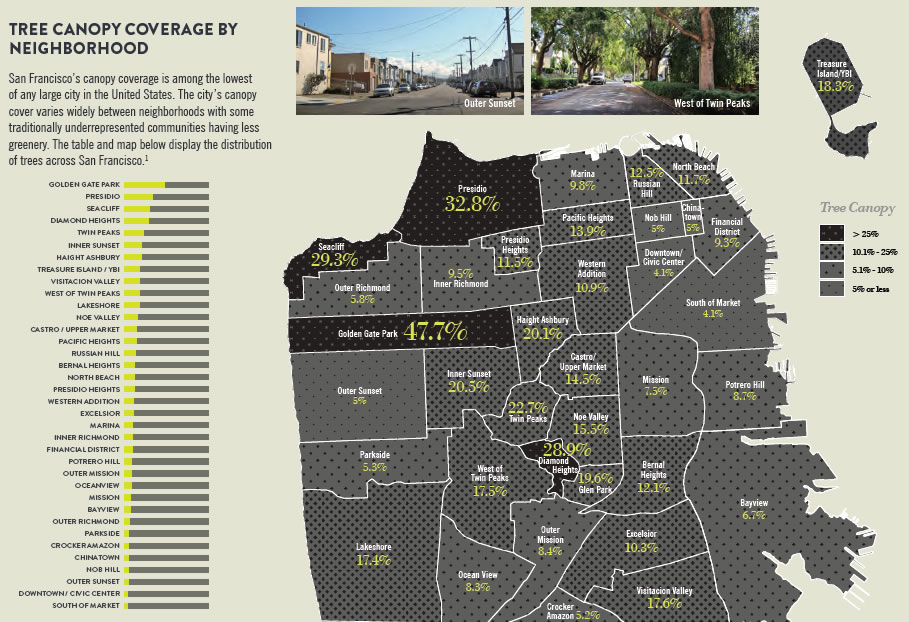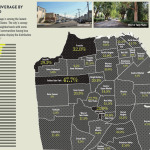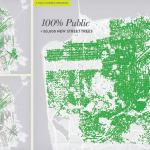While San Francisco is often considered to be one of the “greenest” cities in the world when it comes to renewable energy and zero-waste goals, San Francisco has one of the smallest tree canopies of any major city in the U.S. And to quote the City’s Planning Department, San Francisco “suffers from a literal lack of green.”
At 13.7 percent and shrinking, as new plantings haven’t been keeping pace with old growth deaths and removals, San Francisco’s tree canopy is smaller than Chicago’s (17 percent), Los Angeles’ (21 percent), Seattle’s (23 percent) and New York City’s (24 percent). And it’s less than half of Portland’s 30 percent.
But San Francisco has a plan to grow its Urban Forest.
Phase one of the plan focuses on street trees in the public right-of-way and proposes to establish and fund a new citywide street tree maintenance program and the planting of 50,000 new street trees – an increase of 50 percent – over the next 20 years, with a particular focus on greening those neighborhoods which are currently lacking the most.
The proposed maintenance program – which would need to be funded by way of a parcel tax, assessment or General Obligation bonds – would transfer the responsibility for all of San Francisco’s street trees and related maintenance, including tree-related sidewalk repairs, from private property owners to the Department of Public Works.
Informally presented to the Planning Commission this afternoon, the Plan is expected to be brought before San Francisco’s Board of Supervisors for adoption later this Fall/Winter.
Phase Two of the plan will focus on parks and open space in the city. And Phase Three will focus on recommendations for trees on private property and buildings, including programs to encourage more green roofs and walls.




Here’s a start: Alabama Street between 18th and Mariposa, where trucks have been coming and going all day and night for the past few years, destroying the mature street trees, branch by branch. The drivers laugh about it. Calls to the city to speak with the truck owners go unheeded – like most calls to the city I would bet.
With all the bad press about the City transferring ownership and responsibility of street trees to the adjacent homeowner, it is going to take years to chance this current perception and re-gain property owners cooperation.
Yup, this is a big issue. As is the related one of overhead wires – in the last 6 months I’ve seen 3 notices in my neighborhood to remove street trees (that are finally reaching mature size), because they’re interfering with wires. Remove the wires, not the trees!
so weird because near my house in Bernal there are several trees covering wires and everything seems to be working just fine.
Yes, generally works unless/until a big storm (which we don’t have much of here) or quake. But I think part of my issue is that homeowners (who could be described as lazy, or simply as legitimately concerned about tree maintenance costs) use the overhead wires as an excuse to take out a tree. If there are no wires, then the excuse goes away.
Treeless streets create a hostile environment. So I am in favor of this proposal or any other that will lead to more civilized streets.
How much of a sheltered weenie do you have to be to say that a treeless street creates a “hostile environment’?
An accurate one? Streets without trees are hostile. I’m sorry for whatever you have had done to you that has dulled your perception to the point where you cannot understand a simple sentence and feel so bereft of that sensation that you need to call those who can names.
JB10, maybe a different way of saying that is that trees and other greenery reduce stress, stress-inducing noise and crime and calm traffic.
Considering we started with sand dunes, some rocky hills and a salt marsh it looks pretty green to me.
Sanchez from Duboce to Market. Folsom throughout most of the 20s and name streets. These are the prototypes. Edgewood too, especially when it blooms. Any other streets that others would like to suggest? Plus, encourage neighbors to keep their trees in their yards and to not let neighbors say you have to do some radical pruning because it is hanging over a fence onto someone else’s property!
Landmarking all trees that are of a certain age and size should be commonplace and should not be so hard to do bureaucratically with all that form filing in, gathering support of neighbors and having to prove it from some tree expert. Large, major trees that appear to be old should be allowed to be preserved. We are not talking about Eucalyptus here. I have rarely seen a Eucalyptus outside of those on Mt. Sutro or the ones in Glen Park Canyon (Silver Tree Day Camp). I don’t think Eucalyptus were planted anywhere other than public open space where they were desired to be a wind break. Think that Joyce Kilmer poem which all baby boomers should know…”I think that I shall never see a poem as lovely as a tree….” I doubt they teach that anymore in Elementary school.
i’ll plant and maintain trees in front of my home when i don’t need to worry about utility wires. allowing edibles would also help.
the city needs to realize that the lack of trees is the result of a lot of bad policy decisions – from poor tree choices in the past the both block out light and fall/break in our winds to parking policy that has looked blindly past blocked sidewalks and paveovers. add to that impermeable sidewalks, restrictions on fruit trees, refusal to underwire, the sidewalk police with their spray dots, no gray water programs, and failure to designate which squares are right of way and what can be planted and you get a barren city
Street trees are just the plant kingdom version of rent control.
Exhibit A: San Francisco has incredibly narrow sidewalks and relatively low and densely packed buildings. Where are major trees supposed to go that won’t significantly impair the pedestrian right of way (sidewalk) on the ground and block light to street-facing windows of our low and densely packed buildings?
Exhibit B: It’s nearly impossible to remove or replace a street tree or “significant tree” on your own property. Even crap trees like ficus that the city doesn’t want to see planted. Even dead trees. Even trees whose roots annually destroy sewer lines and sidewalks.
Trees are great and we should have more of them. But we’ll need to expand the sidewalks and eliminate parking lanes for that to make any sense.
There are plenty of avenues in the Richmond and Sunset where the sidewalks are wide, and/or space could be taken from overly-broad streets (without, it should be noted, sacrifycing parking – many avenues are just ridiculously broad for their service level). The fact is, if you can have successful tree cover on the narrows streets of Beacon Hill in Boston (you can, I know, was just there last weekend), you can have tree cover here.
I agree Jeff, here in the Portola and Excelsior the streets are needlessly wide while the sidewalks are narrow and pushed up against the fronts of houses. The city could narrow these streets and add wider sidewalks with tree basins and traffic nor parking would be affected.
While I agree, the problem with a lot of the Sunset area (where I live) is that it was originally dunes. However, that doesn’t mean some native species can’t be planted to spruce up the area…and they don’t even have to have a huge canopy. 8 or 10 feet or just add some decent landscaping like I did (I rent, not own)…to tolerate the wind, fog and salt. What is happening, though, is the city continues to allow homeowners to pave over their entire front yards (mostly to create additional parking) which discourages water run off absorption and makes the area look like a cement jungle of crap. Nothing like gray on gray when the fog has rolled in.
The streets are wide in the avenues too, but the city will never front the huge cost of basically rebuilding each avenue with wider sidewalks. We have to work with what we have, but there are solutions that both the city and homeowners can employ to make the area more green. Pointing the finger at the other party doesn’t get results. Homeowners: take pride. City: help with the cost of greening up the area by providing incentives to homeowners. Also, look at what other cities have done (good and bad) to address this problem.
I agree, the cost of narrowing the streets is massive and probably won’t happen until the streets are so old and failing that they need a major rebuild. I was thinking that a good alternative to narrowing streets might be to change the parking on one side to perpendicular which would increase parking capacity and allow for bulb outs and corners and other features that could then become and opportunity for planting beds and trees. This was done in Doboce triangle many years ago and the results are fantastic.
Another option (though still a bit pricey) would be planted medians (but real medians, not the yucca beds of 19th Ave…). Instead of adding 3 feet to each side, add 6 feet in the middle, planted with trees. (This has the benefit of keeping trees out of the wires, and the roots from cracking sidewalks, as well as reducing complaints about trees shading windows.)
SJ: the medians are a nice touch, but in practicality would really only work on the alphabetical streets in the Sunset, not the numbered ones.
I live in the avenues. my street is not very wide but the sidewalks are huge. Its pretty much that way from 2nd to at least 8th on the north side of geary
The streets (including sidewalks) are at a minimum 70 feet. That’s huge, for a residential street.
we have to get the utilities underground for this to work! so many trees are cut down or otherwise butchered because of the overhead wires, and the options of where to plant them in the first place is limited because of the wires.
more trees would be wonderful!
sign the petition to underground the wires.
i signed the petition. not sure if it will help though
Why does the City Controller’s Office forecast that it would take 600 years to underground all utilities when other larger cities were able to do this long ago? A perfect example of how things work here vs. other cities.
Who put these numbers together—locally + nationally? Planning? Would love to read more…
[Editor’s Note: Our link to the Phase One plan above includes over 80 pages of detailed reading, including methodology and footnotes.]
PG&E has been very lax in their mandate to underground overhead wires, I am not sure about the mandate, but have been told about in the past, could someone who knows more about it comment? [Editor’s Note: 600 Years To Underground Utility Lines In SF At Current Rate.]
Also, some of the other posters are right about the wide sidewalks and streets in the western part of the city, but a friend who has a home out there has told me that large trees are difficult because it is essentially sand under a thin layer of ground cover.
Lastly, although I have had 5 trees planted with the Friends of the Urban Forest in front of my place, I wish they would try to coordinate neighborhoods with their tree selection for a more unified canopy. On the short block I live on there are 7 different types of trees with a total of 19 trees and on one property 7 trees that are poorly maintained because the woman who planted them with FUF cannot afford the pruning that they desperately need. I just spent 2k to have the trees alongside my place to be trimmed and will have to do the same next year.
I think there are more pressing issues the city could focus on than adding more street trees. Most of San Francisco was originally sand dunes and scrub land, and barely had any trees to begin with. There are already infinitely more trees here than there were before it was built up.
There will always be “more pressing issues” than tree planting but I think in the long run it’s just as important to focus on quality of life and beautification issues from time to time. Studies have shown that tree lined streets have many community benefits and despite the lack of trees originally here and the soil, they are still taking root all over the city and helping to create beautiful tree lined streets like you see in Doboce Triangle.
CFB, there are way more people and buildings here now too, and that’s why we need more trees. This “green infrastructure” is essential to a sustainable city. It captures stormwater that would otherwise overwhelm the city’s combined storm-sewer system (which has an annual value to the city of $467,000). See other benefits here.
[Editor’s Note: The Economics of Urban Trees.]
It’s not about “more pressing issues”. There will always be “more”. A city must be capable of taking on and solving many complex issues.
All the time.
The presidio coverage would be much more if it was measured 3 years ago. In the past 3 years, they’ve cut down hundreds of trees because they are “non-native”. theyve cut others doen to widen single track paths. I really don’t agree with cutting down 30+ year old trees for either of those purposes. they have really ruined tons of trails and destroyed alot of the beauty.
I agree with this 100%. Contrast San Francisco with Sacramento, not just L.A.
We just started volunteering with FUF to get more of our neighbors to plant trees in front of their homes, we are finding the that maintenance & sidewalk problems is a big road block in convincing others to sign up for one despite all the benefits. I think this plan is really needed if the city and it’s citizens want to see more tree lined streets.
Undergrounding the wires should be integrated into this plan.
As usual …SOMA dead last in any amenities, but the bright side its number one in just plain old “dead”.
It’s dismal how many streets in my hood, Noe Valley, are void of trees, or barely 3-4 trees per block. I have worked with the FUF in planting various locations, but you would be amazed at how many neighbors do not want trees. Not to mention the ones who have removed a tree and paved over the square.
They complain about leaves dropping. They complain about “too much shade”. They complain about sidewalk cracking.
Pretty sad.
It’s definitely time for the city to take over this task and really make our tree canopy one of the best. I mean, LA has more tree canopy than we do??
Some people will always find something to complain about…just for the sake of complaining. My neighbors have complimented all the landscaping work I’ve done over the past 5 years (trust me, it ain’t fancy) to the house I rent in the Sunset with my partner and our kids. Many of them have asked why would I want to go through all the hassle when it’s so much easier to pave it over or leave it as is, full of weeds, like theirs. First, I enjoy it. Second, I take pride in my house even though I don’t own it. And it’s true…many don’t want landscaping, much less trees, especially if they are responsible for maintenance, like sidewalk repairs, wires, etc.
We have found the same problem in our neighborhood as well, it’s really disheartening that the same people who claim to be green or progressive minded and acknowledge the beauty of tree lined streets won’t put up with some of the relatively minor trade-offs and maintenance issues and somehow find it preferable to live in a sea of concrete. The city just needs to take control of the situation and do it, once people understand how much better their street looks with trees and what a tree lined street does to their property value, their minds often change.
Hurrah for this plan. Let’s green this city ! Through FuF I put a tree in front of my house in the Inner Richmond last year. I was amazed how many of my neighbors were opposed to trees in front of theirs.
i live in the inner richmond. two of my neighbors got in a fight over one wanting to put a tree in front of their home. The other neighbor said it would block the light in his bottom floor apt once the tree grew taller. this is the same jerk who hasn’t painted his house or swept his sidewalk in 40 yrs.
The city plants the trees, but doesn’t maintain them (as in watering and trimming). In the middle of a drought, maybe we should focus on other items, like the sorry state of our roads.
The other issue is trees blocking precious and valuable “views”.